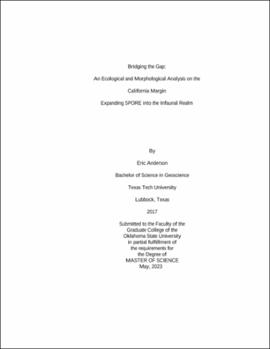| dc.description.abstract | Benthic foraminifera have been widely used by paleoceanography to assess changes in ocean conditions over geologic time. The distribution, abundance patterns, and morphological characteristics of modern benthic foraminifera can serve as modern analogs that allow interpretations within the paleo-realm. This study seeks to explore the ecological significance of pores in epifaunal and infaunal benthic foraminifera as a biological proxy for deep-sea paleo-oxygen. Expanding on the previous work of Rathburn et al., 2018, this study conducts an ecological analysis of four sites within the Southern California Bight. Finding appreciable amounts of shallow infaunal and epifaunal species commonly found at the boundary of oxic and dysoxic waters consistent with the TROX model. With bottom water oxygenation spanning 0.533ml/l to 1.274ml/l, this environment supported populations of Bolivina spissa, Rosalina bradyi, Hoeglundina elegans, along with many taxa from the Reophax and Globobulimina genera. Selecting the most abundant infaunal species, B. spissa, SPORE analysis was performed alongside living and dead populations of Cibicidoides wuellerstorfi. Similar trends to those published in Rathburn et al. (2018) in both species. Variations in SPORE between living and dead individuals varied only slightly, indicating that at least locally, dead individuals can reflect bottom water conditions in a similar way to living individuals. These findings suggest that the SPORE methodology is effective for studying both living and dead populations of C. wuellerstorfi.It was found that B. spissa show a similar, though less pronounced, inverse relationship to bottom water oxygenation consistent with C. wuellerstorfi, fitting expectations as a shallow infaunal species, much more tolerant to low oxygen conditions. Downcore, however, did not follow our expectations. SPORE values decrease with increasing depth within the sediment. Specific pore water geochemistry was not available for this study and could hold key insights into these observed trends. Further research is currently being conducted examining B. spissa both downcore and on average across a wider oxygen gradient. These works will continue to bolster the established C. wuellerstorfi data and begin to expand on these initial insights observed in this study. | |
